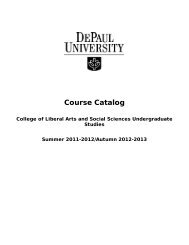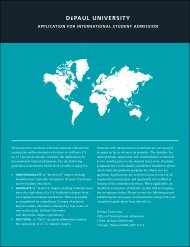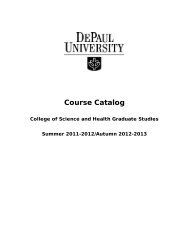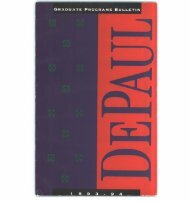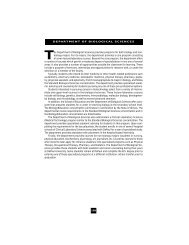Create successful ePaper yourself
Turn your PDF publications into a flip-book with our unique Google optimized e-Paper software.
tThe Chinese studies major in the modern languages department<br />
launched in fall 2006 is a prime example of how the university is<br />
developing resources to meet those needs. A recognition not only of<br />
the fast-growing power and influence<br />
of China, but also of its rich culture,<br />
the new program builds on the existing<br />
Chinese language minor and Chinese<br />
teaching programs, integrated with<br />
relevant courses in other disciplines<br />
such as history, the arts, religious<br />
studies and political science.<br />
“We’ve combined talents and<br />
disciplines to create the strongest<br />
curriculum of any Chinese program in<br />
the Midwest. The program emulates<br />
our highly successful interdisciplinary<br />
Japanese studies major, which enrolls<br />
nearly 300 students each year and<br />
is the largest program of its kind in<br />
the Midwest,” says Johnston.<br />
Like the Japanese studies<br />
program, which has been in existence<br />
for more than a decade, one of the new<br />
Fojas<br />
program’s goals is to generate K-12<br />
teachers capable of preparing incoming<br />
students for advanced international<br />
studies. Already, several Chicago-area<br />
schools offer Chinese, and the Chinese<br />
language program in Chicago Public<br />
Schools is one of the largest in the<br />
nation. “We are the only university<br />
in Illinois that offers certification for<br />
Chinese language teachers,” notes<br />
Johnston. “This will feed back into<br />
our Chinese studies program.”<br />
McCloud<br />
<strong>DePaul</strong> also has created three<br />
separate majors in Spanish or<br />
Latino studies to recognize a population that is too often lumped<br />
into one culture, and which today is so intertwined—commercially and<br />
otherwise—with the United States and with Chicago.<br />
“Chicago is the third largest Latino market in the United States,<br />
behind only Los Angeles and New York. Above Miami, even.<br />
That’s astonishing,” says Johnston. “And the people—whether they’re<br />
Mexican, Honduran, Cuban and on<br />
and on—the frequency with which<br />
they go home and how freely we<br />
move across the border now demands<br />
that we know each other.”<br />
The pursuit of profit is often the<br />
driving force behind this flattening<br />
of the globe, but commercial success<br />
shouldn’t come at the expense of<br />
everything else, Camilla Fojas, associate<br />
professor and director of Latin<br />
American and Latino studies, points<br />
out. “We are living in a globalized<br />
world. This is especially so in a global<br />
city like Chicago that is the recipient<br />
of people, goods and services<br />
from all over the world,” she says.<br />
“That said, it is cynical and<br />
perhaps mercenary to think that<br />
literacy in other cultures and<br />
languages is useful only as a means<br />
to success in a globalized market.<br />
The critical appreciation of the<br />
experiences, history, politics and<br />
cultural work of racial and ethnic<br />
minorities is crucial to becoming a<br />
thoughtful, intellectually curious,<br />
empathic and culturally literate member<br />
of a global society,” Fojas says.<br />
Course offerings such as those<br />
which cover such issues as the<br />
nature of the immigrant experience,<br />
social diversity in Latin America,<br />
and the Hispanic experience in<br />
music, literature and art are just a few examples of the ways in which<br />
the curriculum addresses this need for Latino studies students.<br />
16 f e a t u r e




